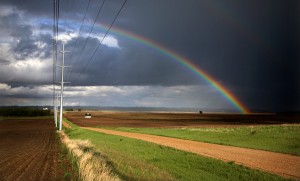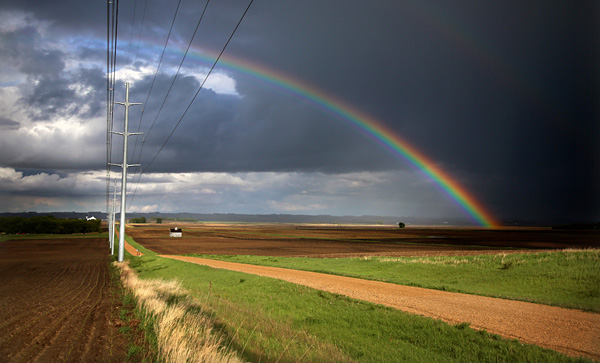 By Jennifer Bjorhus and Mike Hughlett, Star Tribune (Minneapolis) –
By Jennifer Bjorhus and Mike Hughlett, Star Tribune (Minneapolis) –
MINNEAPOLIS — Mick Schmiesing strides into the local rec center in a plaid shirt, Massey Ferguson tractor cap and old tennis shoes. It’s auction day, and he’s ready to make a play for 80 acres of soil in Blue Earth County, Minn.
Bidding starts at $5,000 an acre.
(PHOTO: With skyrocketing farmland prices and crop insurance guarantees, farmers are looking for the gold at the end of the farming rainbow as depicted over Gene Stoel’s farm south of Lake Wilson. Stoel, looking to expand his farm, purchased an additional 160 acres last fall for $6,800 per acre.)
A year ago, that would have been about the going price for good land in this southern Minnesota county. On this day in March, the bids climb much higher, past the county record set just a month earlier. After a few tense minutes, Schmiesing wins out with an offer of $8,375 an acre.
He looks a bit stunned — he just spent $670,000.
Is the land worth it? “I have no idea,” he says. “I’ll tell you in five years.”
Across Minnesota and the Midwest, concerns are rising that farm values are climbing too high. Farmers, bankers and investors have put huge sums of money on the line, in the hope that boom times for agriculture will last.
Land prices have reached levels not seen in a century, even adjusted for inflation, mainly because historically high prices for commodities such as corn and soybeans have enabled farmers to generate strong profits. Good times are spurring farmers to expand their holdings and newcomers to buy in.
But economists and analysts wonder whether farmland will continue to provide the kind of payoff that justifies the high-dollar purchases. Or whether farm prices are vulnerable to the kind of momentum shifts that hit dot-com stocks and then housing.
“If (prices) keep going up at the rates at which they have been going up, they will not be justifiable,” said Brent Gloy, director of Purdue University’s Center for Commercial Agriculture.
Farming’s last golden era also started with high commodity prices and a big run-up in land values — only to collapse into what became the 1980s farm crisis. Legions of farmers went bankrupt, and land values plummeted, devastating rural economies.
Many observers say farmers are at less risk this time because they aren’t carrying as much debt as they were in the ’80s. But signs of overinflated land prices have people on guard that the market may be peaking.
“As a conservative banker, I’m concerned every day,” said Michael Bahl, principal agriculture industry specialist at Wells Fargo Bank in Owatonna, MInn. He thinks Minnesota farmland that has reached $8,000 to $10,000 an acre is “too high.”
Purdue’s Gloy watches the “value-to-cash rent multiple” of farmland, which indicates how much buyers are paying for each dollar of rent they could collect for the land. A high number suggests that buyers may be overpaying.
The ratio hit a high in Minnesota in 2007 and remains at levels not seen in 45 years, according to a Star Tribune analysis of U.S. Department of Agriculture data. It’s at similar highs in Iowa, Illinois and Indiana and hasn’t fallen back in those states, according to Gloy’s analysis.
“We’re in uncharted territory,” Gloy said.
Farming is the ultimate hard-luck profession, forever at the mercy of weather and faceless commodity markets. In recent years, though, the rewards for many crop farmers have been bountiful.
Sitting in his home office in southwest Minnesota overlooking two large shiny new steel corn bins, Gene Stoel sums up the past couple of years: “It’s been very easy to make money,” said Stoel, 57, a veteran corn and soybean farmer near Lake Wilson, Minn. “This has been a very good age for farming.”
Farmers can thank much of their current good fortune to the combination of historically high commodity prices and historically low interest rates.
High prices for corn and other grains, of course, boost farm income. Low rates make borrowing cheaper and intrinsically raise the value of a farm.
There are so many risks that Bahl, the Wells Fargo banker, joked he can’t list them all.
“Any one thing could cause that disaster,” he said.
Interest rates will inevitably rise at some point, although the Federal Reserve has made clear that it intends to hold rate targets low until at least 2014. Ethanol demand has slowed, and farm economists say that without federal policy changes, the days of go-go growth for the corn-based fuel are gone.
“Corn is land, and land is corn,” said Michael Swanson, an agricultural economist with Wells Fargo in Minneapolis. “If we have $6 corn prices going forward, these land prices are fine. We really need to have a couple of monster crops to see how low these prices might go.”
Producers themselves, and the age-old specter of such “monster crops” pose their own threat. Farmers worldwide, not surprisingly, react to higher prices by planting more, which in turn can lead to bumper crops that inevitably lead to price declines. U.S. corn farmers were expected to plant more acres in corn this year than any time since 1937.
“In the past, farmers have tended to produce themselves out of prosperity,” said Jason Henderson, an economist at the Federal Reserve Bank of Kansas City.
Then there’s rising costs for farm essentials like fertilizer and seed. Indeed, despite Minnesota crop farmers’ banner year in 2011, profits were still down almost 10 percent from 2010 due to higher costs.
Bankers are busy charting the shrinking profit margins. A sudden spike in oil prices, for instance, could alter the farm equation.
Stoel, like many farmland watchers, is bullish on world demand driving higher prices. As chairman of the Minnesota Soybean Research and Promotion Council, he’s been to Asia and seen the success story firsthand: “As they increase income, the first thing they want is a better diet.” Demand for more meat spells demand for more animal feed.
Still, he cites a slowdown in emerging nations as his biggest worry.
Gloy, the Purdue economist, said he’s concerned that global growth “is taken on faith.”
The inevitable comparison for farm prices is the housing bubble.
But home values surged well beyond people’s incomes, a warning sign for trouble. On the farm, commodity prices and incomes have soared at similar rates to land prices.
And economists are quick to point out that farmers are far less leveraged today than in the 1980s, when high debt levels greatly amplified fallout from the agricultural downturn. Debt levels, while rising over the past decade, are a bit less than half of what they were during that crisis.
That could change, of course, if historically low interest rates inspire more borrowing. Will farmers and bankers go on a credit spree?
“That’s the key question,” Henderson said.
Farmers and bankers alike say lenders are more conservative than during the previous boom. Back in the late 1970s and early ’80s, Haag said you could ask a bank for $50,000, only to hear, “How about $100,000?” And they’d let borrowers put considerably less of their own cash into a deal.
Haag made it through the ’80s farm bust intact but saw collapsing farm values firsthand. That experience still guides him, he said.
“My group that went through it — the ’80s — we are being very careful. You saw guys who were very good farmers overextend themselves and lose it.”
Some of the state’s largest farm lenders, such as Wells Fargo, AgStar, Rabo Agrifinance and Bremer Bank, said they generally lend up to 60 to 65 percent of the land’s value — although that limit is coming down, some said.
The farmer has to provide the rest with cash, or with a combination of cash and mortgaging land the farmer already owns outright. In some cases, pledging already-owned land as collateral enables farmers to buy land with zero cash down, bankers said, although that’s not common.
Bahl, at Wells Fargo, said the bank likes to have 10 to 20 percent in cash.
“We’re not going to let the farmer overleverage themselves,” Bahl said. “Bubbles are created when people overleverage themselves and put themselves in a bad position. Conservative lending practices are not allowing that to happen.”
Paul DeBriyn, CEO of AgStar Financial Services Inc. in Mankato, said farmers are better managers now, with better technology available to them. Prices will come down, DeBriyn said, but “it’s hard to imagine we’d have anything close to the ’80s.”
The risks aren’t lost on farmers. Schmiesing, who just bought the 80 acres in Blue Earth County to grow more corn, said he’s perfectly aware of them. He just doesn’t think corn prices will fall “for a while.”
He and his brother, who run a hog operation, had to mortgage some of the 1,500 acres they farm with their father to pay for the new land. He said he probably wouldn’t have bought if it hadn’t been right next door.
“It’s just like going to Morton, you know,” said Schmiesing, referring to the Jackpot Junction Casino in Morton, Minn. “That’s what farming is, it’s a gamble every day.”
“It’s good right now. I don’t know how long it will last.”









